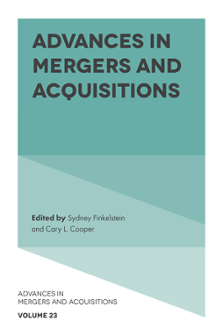
Index
Advances in Mergers and Acquisitions
ISBN: 978-1-83608-073-2, eISBN: 978-1-83608-072-5
ISSN: 1479-361X
Publication date: 8 July 2024
Citation
(2024), "Index", Finkelstein, S. and Cooper, C.L. (Ed.) Advances in Mergers and Acquisitions (Advances in Mergers and Acquisitions, Vol. 23), Emerald Publishing Limited, Leeds, pp. 153-158. https://doi.org/10.1108/S1479-361X20240000023011
Publisher
:Emerald Publishing Limited
Copyright © 2024 Sydney Finkelstein and Cary L. Cooper
INDEX
(see also Serial acquirers)
(see also Cross–border mergers and acquisitions (CBMAs))
- Prelims
- Chapter 1: A Review of Research on Cross-Border Mergers and Acquisitions: Impact, Themes, and New Directions
- Chapter 2: Modification of MNE Strategies in the Face of Financing Constraints
- Chapter 3: Acquisitions by Multi-business Firms: A Divisional Lens
- Chapter 4: The Performance of Serial Acquirers: A Review and Integrative Framework
- Chapter 5: Outsourcing Experience: Examining Market Responses to Acquirers Relying on Advisor Experience
- Chapter 6: Middle-Status Opportunism: Financial Advisors and Their Risky Acquisition Endorsements
- Chapter 7: Capabilities in Conflict? The Fallacy of Sameness Between Divestitures and Acquisitions and its Ramifications for Firm Capability Development and Deployment
- Chapter 8: Strategic Choices Between Alliances and Acquisitions: What Do We Know and Where Do We Go from Here?
- Chapter 9: Down the Wrong Rabbit Hole: Methodological Traps in Researching Emotions in Post-Merger Integration
- Index